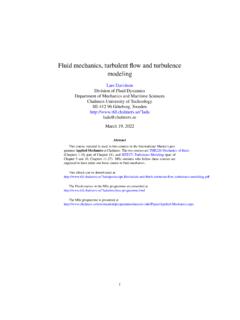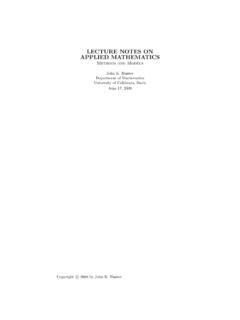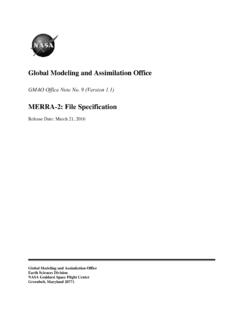Transcription of Partial Differential Equations (PDEs)
1 New Mexico Tech Hyd 510 Hydrology Program Quantitative Methods in Hydrology -167- Partial Differential Equations (PDEs) This is new material, mainly presented by the notes, supplemented by Chap 1 from Celia and Gray (1992) to be posted on the web , and Chapter 12 and related numerics in Chap. 21 in Kreyszig. Fundamentals of Partial Differential Equations We ll first examine the motivation for studying PDEs, then examine their nature and classification, and finally talk about various solution methods. Recall that the basic attribute of a PDE is that it has two or more independent variables. In most applications these represent time and space. We have one time dimension and up to three space dimensions. These independent variables can be present in any combination, but at least two of them must be present to be considered a PDE. In presenting this material we usually represent time by the symbol t, and space by conventional Cartesian coordinates x,y,z. However, as you see in the reading from Celia and Gray (1992), we can treat all four as independent variables without worrying about exactly what they represent.
2 Thus, in a generic approach t represents an independent variable which could be time, space, or even something else. Since by convention the symbol y is now an independent variable we can no longer use it to represent the unknown, dependent function. In any one application, we have a specific symbol for the unknown, such as p for fluid pressure, h for hydraulic head, C for solute concentration, T for temperature, and so on. In the mean time we need a generic symbol for the unknown to use when we are not examining a specific application. Celia and Gray, and your text book, both adopt the convention using u as the independent variable. In general, in three-dimensional space, and where t can represent time, we have Independent variables x,y,z and t Dependent variable u = u(x,y,z,t) Of course, to be a PDE there need only be two independent variables, and that is where we start. Consequently we examine problems where u(x,t) or u(x,y).
3 As we examine things generically the symbols for y and t can be freely substituted for each other. We are also examining PDEs that have both 1st or 2nd order terms, or both, in them, as well as the possibility of zero order terms. Most will have 2nd order terms. Motivation Most of the PDEs that we encounter represent a intensive conservation equation, that is, the conservation of mass, energy or momentum per unit volume per unit time. Each of these conservation or balance Equations has three components, which can be written out in simple terms for a hypothetical control volume as Time rate of change of storage = Net flux rate in + Net source rate. New Mexico Tech Hyd 510 Hydrology Program Quantitative Methods in Hydrology -168-The units would depend on what is being conserved. If mass, then the first and other terms have units of [kg m-3 s-1]. If heat energy the units would be [J m-3 s-1], while if momentum they are [kg m-2 s-2]. Of course, one could multiply through by a constant and get some other consistent units.
4 For example, if the space domain is one dimensional we often multiply by a unit area [m2]. Or if preserving fluid mass for an incompressible fluid containing only a dilute concentration of solutes, you might divide by fluid density, and end up with an equation preserving fluid volume instead. This latter approximation is common in hydrology. The time rate of change term appears as something like u/ t, or S u/ t, where S is any storage-like coefficient. For fluids it represents compressibility effects, for heat transport in a fluid or solid it is heat capacity, and for solute in a porous media it is porosity. There are typically two kinds of fluxes that concern us. To explain this, let s focus on conservation of solute mass, but realizing that these concepts also apply to fluid energy and momentum. The first flux is that due to solute advection with the flowing fluid (solute concentration, C, times the fluid velocity, v, or in other words, flux = vC). This leads to a first derivative contribution in the conservation equation.
5 Why? The conservation equation is concerned with changes in concentration, and the advective term specifically deals with spatial changes caused by a flowing fluid. Using a Taylor series approach, we take the derivative to get at the rate of change ( , (vC)/ x )1. That is why the 1st derivative ends up in the model . The second type of flux is due to diffusion or something that has the same type of mathematical representation (a so-called homology). Molecular diffusive flux is modeled by Fick s Law, in which the flux is proportional to the gradient of concentration. The proportionality coefficient D is called the molecular diffusion coefficient, and in 1D the flux = - D C/ x. Again, we use a Taylor Series approach to get the rate of change of diffusive flux ( , [- D C/ x] / x = -D 2C/ x2 if D is constant) to insert in the conservation equation. Many transport processes have this behavior, such as fluid momentum diffusion (D = kinematic viscosity, Newton s law) and thermal energy diffusion (D = thermal diffusivity, Fourier s Law).
6 Other, upscaled, transport processes have a homologous behavior, such as fluid turbulent eddy diffusion (D = eddy viscosity), porous media solute dispersion caused by spatially varying velocity (D = aquifer dispersion coefficient), and aquifer flow (D = hydraulic diffusivity = K/Ss, where K is hydraulic conductivity and Ss is specific storage). Below keep you eye out for one or both types of fluxes advection and diffusion. In our adapted notation the x-direction fluxes are given by vu and - D u/ x, which appear in conservation Equations (rate of change of flux) as something like (vu)/ x and -D 2u/ x2, where v is velocity and D is the diffusion coefficient. The net source term on the right-hand-side (RHS) of the conservation equation refers to sources-sinks. The sources and sinks can include first-order terms that are proportional to state variable u, and zero-order prescribed terms (not depending on u). Some common generic PDE examples of relevance to hydrology are 022= xuDtu The 1D diffusion equation, u(x,t) (1) 1 In our later development, for many of the examples, we assume v is a constant.
7 Thus (vC)/ x = v C/ x. New Mexico Tech Hyd 510 Hydrology Program Quantitative Methods in Hydrology -169- 0= + xuvtu The 1D advection equation, u(x,t) (2) where v and D are parameters, 022= + xuDxuvtu The 1D advection-diffusion equation, u(x,t) (3) 02222= + yuxu The 2D LaPlace equation, u(x,y) (4) ),(2222yxfyuxu= + The 2D Poisson equation, u(x,y) (5) 0222222= + + zuyuxu The 3D LaPlace equation, u(x,y,z) (6) 0222222= + + yuDyxuDxuDyuvxuvtuyyxyxxyx u(x,y,t) A 2D advection-diffusion equation (7) 0222222= + + zuyuxuDtu The 3D heat-conduction equation, u(x,y,z,t) (8) where vx ,vy , Dxx , Dxy and Dyy are parameters.
8 Notice in equation (7) we have a second order, so-called cross-derivative term involving both x and y. The presence of cross-derivatives affects the choice of solution method. Also notice that one of these Equations has four independent variables, two have three independent variables, and the rest have two. Each of these examples has been used to model solute movement and heat transfer for an appropriate conceptual model . Equations (1), (4), (5), (6) and (8) are also used to model groundwater flow2. Equations (3) and (7) are used to model flow in the vadose zone, where v represents the influence of gravity. We could add first order terms ( u) and zero-order forcings (like that in the Poisson equation) to expand the population of hydrologically relevant Equations even more. 2 You might wonder why we don t include the equation for fluid flow in a river or the atmosphere. The most general form of these Equations is called the Navier-Stokes equation, representing Newton s second law.
9 It is more complicated than the Equations here, and highly non-linear. Recall Newton s second law, the rate of change of momentum equals the sum of applied forces. Its nearest relative above is the advection-diffusion equation (3). The storage, advection, and diffusion terms of (3) would then represent the time and space rate of change of momentum. You would add forces to the right side as net sources of momentum; typically we add gravity and other body forces. In any event, our study of solutions of the advection-diffusion equation provides the foundation for solving the Navier-Stokes Equations and other more sophisticated models. New Mexico Tech Hyd 510 Hydrology Program Quantitative Methods in Hydrology -170-Notice that our list doesn t include a wave equation, like 02222= xutu (9) This looks similar to the LaPlace equation (4), but the difference in sign causes a significant difference in behavior modeled and in the nature and method of solution.
10 Your textbook focuses on this equation, and it is also discussed in Celia and Gray (1992). It has interesting properties and wide application ( , vibrations, water waves, flood waves, seismicity, etc.). It is just not so important or applied in hydrology as the other Equations (major exception: using geophysical tools for characterization). You can study this equation in your text (Chapter 12) and in more advanced classes. We skip it here. Example: Suppose a toxic solute is accidentally released to a river. Shortly downstream it will have mixed transversely across the river, due to turbulence . Let C represent this (cross-sectional) mean solute concentration. The solute then advects downstream with the mean river velocity and disperses in the longitudinal direction (along the river axis) due to velocity differences across the channel (velocity is lowest near the bottom and banks, and highest toward the center of the rivers; solute moves faster near the center causing an apparent spreading along the stream axis).










